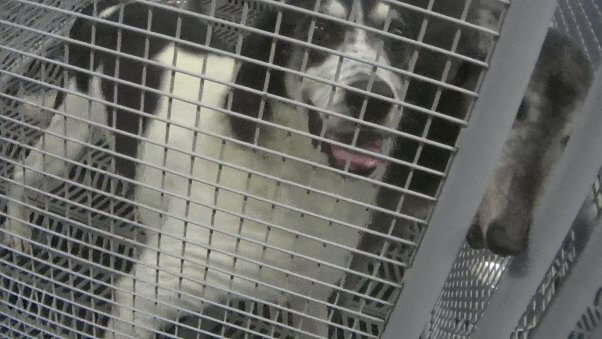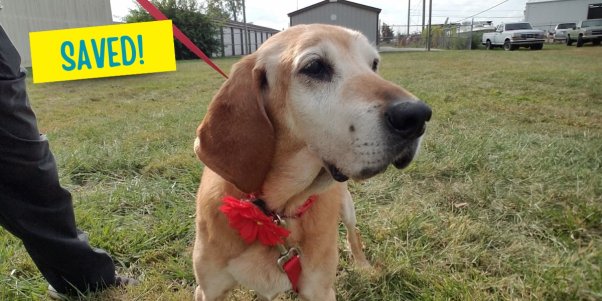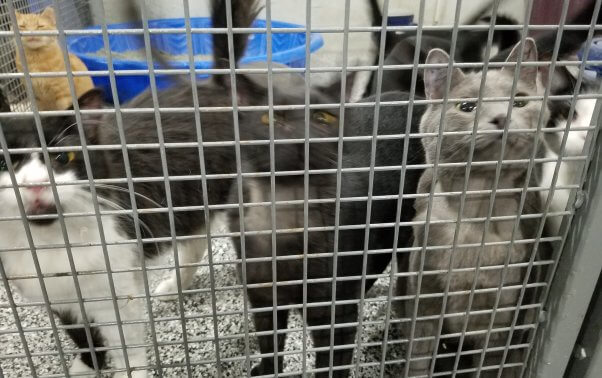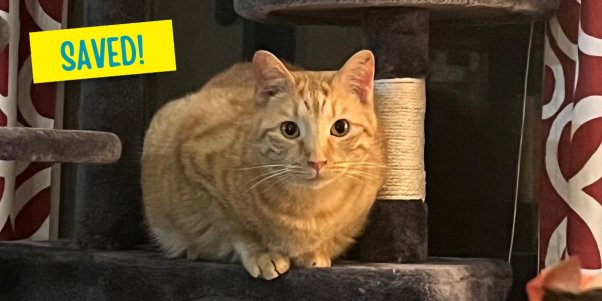Where Does YOUR Vet Get Transfusion Blood From? Do Ask!
PETA Reveals Hundreds of Dogs and Cats Bled and Caged Until Death
Imagine being confined to a cramped cell and being taken to have nearly a pint of your blood drawn every three weeks for a decade or more. This was Squiggy’s reality. At age 15, he was the oldest surviving dog at The Veterinarians’ Blood Bank (TVBB) – an Indiana operation that perpetually confines nearly 900 dogs and cats to barren kennels or crowded pens and sells their blood to veterinary clinics.
After a lifetime of being used as a blood factory, never knowing the warmth of a home or the love of a family, TVBB finally euthanized Squiggy – releasing him from the loneliness and repeated poking and bleeding. But hundreds of other dogs and cats remain at the facility, condemned to the same miserable existence.

Never-Ending Needle Pricks and Blood Draws
A PETA undercover investigation into TVBB found that dogs’ blood was taken beginning when they were only 6 months old. Most animals at the facility remain there for life – deprived of joy, comfort, affection, and even a blanket to lie on. Even those whose blood was no longer taken were warehoused indefinitely, including elderly cats who were confined to a dismal pen that workers callously called the “stairway to heaven.”
Lay workers with no veterinary credentials administered vaccines, anesthetized animals, stitched up wounds, and performed “dentals.” A worker extracted eight blackened teeth from a dog named Foster, who struggled to breathe under anesthesia. Others’ teeth were left to rot in their mouths.
Kolbie, a 12-year-old hound, had been debarked in what a worker called a “horrible” and “gruesome” surgery that the blood bank’s owners performed to stop her from howling. Kolbie likely would have died there if PETA’s investigator hadn’t worked hard to adopt her. The investigator also rescued three cats in bad condition.

Kolbie had been debarked in a “horrible” and “gruesome” surgery.
No Comfort, No Escape
Dogs at TVBB spent more than 23 hours a day – and all day on Sundays – in small, barren, deafeningly loud kennels. Many had pressure sores and growths from lying on hard, grated floors. Cats, crammed by the dozens into pens with nothing to do and no space to themselves, climbed the chain-link walls out of frustration.
Stressful conditions led to fights among dogs. Howard was attacked at least three times by his kennelmate, and after Clara and Parker fought, they were still let out together, resulting in a fight that left Clara with a severe leg wound that required staples.

Workers Paid Blood Money for Strays
TVBB obtained its victims by breeding them or acquiring them as strays or through “free to a good home” ads. A manager offered workers $200 for each cat, saying, “Where you get [them] from is not my business.” Workers brought in homeless animals and kittens they found on Facebook.
Sick Animals’ Blood Sold to ‘Help’ Veterinary Patients
Some animals tested positive for contagious conditions, including feline herpesvirus and mycoplasma, but TVBB eventually used their blood anyway. Workers drew blood from dogs like Baxter, who apparently had bone cancer and who died alone in his kennel, and cats such as Chelsea, who had lost more than 10% of her bodyweight in three weeks.
TVBB took blood from animals who were elderly, emaciated, injured, medicated, or sick – potentially compromising the health of both the unwilling “donors” and the recipients of the blood, who are often critically ill or injured.

Beautiful Jane, who had become too sick for blood draws, was rescued in the nick of time.
Freeing the Forced ‘Donors’
TVBB isn’t the only such facility. In 2017, PETA revealed that The Pet Blood Bank in Texas kept 151 greyhounds in solitary confinement inside dirt-floored pens in an old turkey shed and severely neglected them. Dogs had severe dental infections and painful open wounds, and they were reduced to spinning in endless circles and crying out in despair. Under pressure from us, The Pet Blood Bank closed and released the dogs for adoption.
The following year, we investigated Hemopet, a canine blood bank in California that warehoused approximately 200 greyhounds discarded by the racing industry. Since then, a landmark bill was passed, thanks to PETA. Now, veterinarians in that state can dispense blood donated by healthy dogs who live in loving homes instead of blood from captive canines. But other animals still need your help.
Be Part of It!
After hearing from PETA and thousands of supporters, BluePearl Pet Hospital, PetVet Care Centers, and VCA Animal Hospitals dropped TVBB as a supplier. Please share this article with your veterinarian and ask them where they get their blood from. Urge them to obtain blood only from cats and dogs who live in loving homes and are volunteered by their guardians to periodically “donate.”



